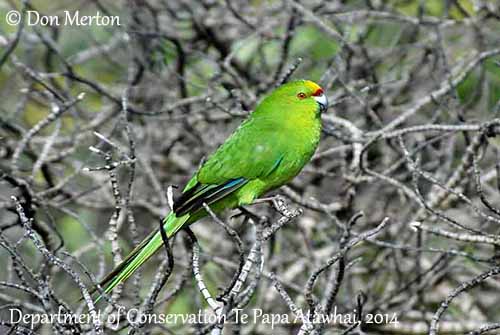
Fr : Perruche des Chatham
Ang : Chatham Parakeet - Forbes's Parakeet
All : Chathamsittich
Esp : Perico de las Chatham
Ita : Parrocchetto delle Chatham
Nd : Chathamkarakiri
Sd : Chathamparakit
Photographer:
Don Merton,
Courtesy of Department of Conservation Te Papa Atawhai, 2014
Department of Conservation
Text by Nicole Bouglouan
Sources:
HANDBOOK OF THE BIRDS OF THE WORLD vol 4 by Josep del Hoyo-Andrew Elliott-Jordi Sargatal - Lynx Edicions - ISBN: 8487334229
PARROTS OF THE WORLD – An Identification Guide – by Joseph M. Forshaw – Princeton University Press – ISBN 0691092516
BirdLife International (BirdLife International)
New Zealand bird status between 2008 and 2012
Te Ara – The Encyclopedia of New Zealand
Chatham Parakeet or Forbes’ Parakeet
Cyanoramphus forbesi
Psittaciformes Order – Psittaculidae family
INTRODUCTION:
The Chatham Parakeet was formerly treated as a race of the Yellow-fronted Parakeet (C. auriceps) which is very similar in appearance but smaller. However, the Chatham Parakeet is also close to the Red-crowned Parakeet (C. novaezelandiae).
Actually, from genetic comparisons, the Chatham Parakeet is probably descended from an ancient lineage which occurred on the Chatham Islands before other parakeets colonize this region.
The Chatham Parakeet is abundant on Mangere and Little Mangere Islands, but this species has suffered heavy hybridization with the subspecies Cyanoramphus novaezelandiae chathamensis.
Today, the Department of Conservation is monitoring this problem and there are less than 10% of hybrids in the current range.
DESCRIPTION OF THE BIRD:
Biometrics:
Length: 28 cm
Weight: 80 g
The adult has emerald-green plumage, with more yellowish underparts. It has broad, rounded wings, with greenish-blue outer webs of flight feathers. The tail is long and graduated. There is a crimson-red patch on each side of the rump.
On the head, the sides of the face are bright emerald-green. The frontal band does not extend to the eye like in C. auriceps. The forecrown is bright yellow.
The bill is silvery-grey with black tip. The eyes are red. Legs and feet are grey.
Both sexes are similar, but the male is larger than the female.
The juvenile is duller overall, with duller head pattern and eyes.

RANGE:
The Chatham Parakeet is now found in the dense vegetated areas of Mangere and Little Mangere Islands in the Chatham Island group, New Zealand. Some vagrants can be seen occasionally on Pitt and Chatham Islands.
HABITAT:
The Chatham Parakeet usually occurs in dense vegetation and forest on both islands, but it was formerly living in the forested areas of Pitt and Mangere Islands before deforestation.
CALLS AND SONGS: SOUNDS BY XENO-CANTO
The Chatham Parakeet utters typical chatter and softer “tur-tur-tur” calls. A repetitive “ki-ki-ki-ki” can be heard in flight.
BEHAVIOUR IN THE WILD:
The Chatham Parakeet feeds mainly on invertebrates, flowers and seeds in October/November, whereas leaves and other seeds are taken in March/May.
This species often forages on the ground, in more open areas than C. auriceps, because it is living on predator-free islands.
The Chatham Parakeet is a cavity-nester like other Psittaciformes. Both adults defend aggressively the nesting territory against other pairs, chasing the intruders while calling loudly.
This species is sedentary and the pairs occupy their territories all year round. However, they sometimes reach the southern forests of Chatham Island, at about 20 kilometres from Mangere Island, and they are occasionally seen on the nearby islands of Pitt and Rangatira.
The flight is strong, swift and slightly undulating.
REPRODUCTION OF THIS SPECIES:
The breeding season is fairly extended, and the laying occurs from October to March.
The Chatham Parakeet nests in cavities such as hollows in trees, rock crevices or under thick vegetation, but also in artificial nest-boxes. The female prepares the nest.
She lays 5 white eggs and incubates alone, broods and feeds the young until two weeks of age. However, all the food is provided by the male during this period. Then, both parents feed the chicks at nest until they leave the cavity.
This species can produce replacement clutches is nest-failure occurs, according to the food resources.
PROTECTION / THREATS / STATUS:
The Chatham Parakeet was formerly threatened by deforestation, habitat changes and introduced cats. By the 1970s, there were less than 75 birds.
But conservation efforts have allowed extensive reforestation, availability of nest-boxes and management of the race Cyanoramphus novaezelandiae chathamensis and hybrids on Mangere Island, involving more suitable habitat and better numbers of parakeets.
The species is now common on Mangere Island, and birds will be introduced into predator-free areas on Chatham Island.
The numbers of mature individuals are placed in the band 50/249 birds. The population is estimated stable and probably increasing, but due to its restricted range, the Chatham Parakeet is considered as Endangered.